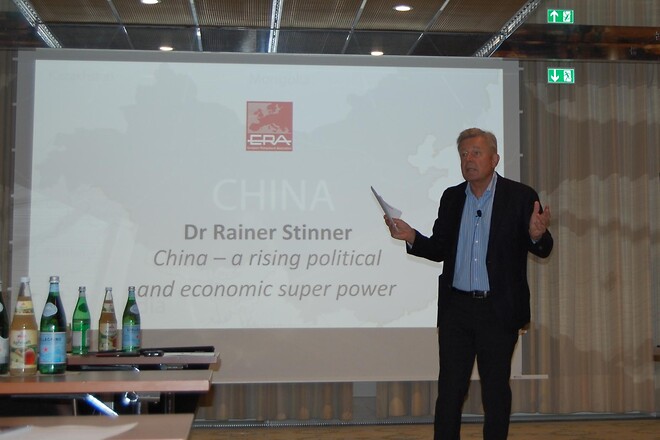ERA höll årsmöte i Hamburg
Under mötet togs en rad branschaktuella och branschgemensamma ämnen upp. Bland annat den om användning av trioxid vid plätering av tryckcylindrar, utvecklingen av individualiserat tryck och mindre upplagor riktade mot specifika målgrupper och en hållbarhetsanalys över djuptryck som visar dess miljöfördelar.
Till de mer branschspecifika föredragen kom också mer övergripande ekonomiska analyser och utsikter med anledning av den pågående Corona-pandemin och totalitära Kinas utveckling mot en supermakt.
För mer information läs det engelska referatet nedan från ERA. I slutet finns också en länk till fler bilder och presentationerna på konferensen.
ERA’s Annual Conference & Management Meeting took place in Hamburg on 5-6 October 2020 in the Hotel “Grand Elysée”. Despite meeting and travel restrictions due to the ongoing corona pandemic ERA’s Annual Conference was attended by some 50 delegates from the European gravure industry.
The conference included presentations on publishing, technical and socio-economic subjects by experts from the industry and external. ERA Secretary General James Siever concluded:
– The lively discussions among the delegates during the conference have shown that personal meetings and exchange of information cannot be replaced by virtual meetings.
A visit to Prinovis’ publication gravure plant in Ahrensburg in the afternoon of 5 October rounded off the programme of the event.
A subject of high concern for the gravure industry is chromium trioxide which is used for the plating of printing cylinders. Dr Julian Rotter of Kaspar Walter commented on the status of the ongoing authorisation process. Since a motion against the authorisation was rejected by the European Parliament it is expected that the competent EU Commission will soon approve the authorisation.
To secure the use of chromium trioxide beyond 2024 when the currently running application will expire, he referred to Kaspar Walter’s ChromeXtend initiative. Alternatives to chromium trioxide are under development, however not ripe to use on industrial scale for the time being.
The publishing of print media is influenced by the ongoing digitalisation in the market place. Sandra Grundner and Tanja Pfisterer-Lang of rtv media group in Nuremberg, subsidiary of Bertelsmann Printing Group (BPG), explained their portfolio of customized print products for targeted mass audiences.
Instead of one product with high circulation new products with individual target groups and smaller print run were created, which requires higher efficiency and flexibility from the printer. Their major product is still rtv, Germany’s TV magazine with the highest print run, which is distributed through regional newspapers.
Another transformation example was shown by Ingo Raab of Burda Druck who presented the new ADAC Motorwelt which is published and produced by Burda since the beginning of this year. Layout, format and content of the ADAC Motorwelt were revamped, and it has become a high quality magazine with a focus on mobility.
The print run is now 4,5 million copies per quarter instead of 14 million monthly. And instead of distributing the magazine to the household of each ADAC member, the magazine can be picked up by the ADAC member free of charge at some 9 000 points of sales at the supermarket chains Edeka and Netto.
In the technical session Dr Carlo Werlé of Dalim Software made a ride through Dalim’s history as a partner of the printing industry and described their software solutions for a fully integrated workflow from prepress to press. He also announced the opening of a Dalim office in the UK on 1 October.
Dr Kai Baer of Adphos Digital Printing discussed the impact of the CO2 tax, and how savings on energy consumption could be realised. Print consultant Gabriele Kirchmeier presented a study on the “strength and ecological aspects of gravure printing”. Her conclusion: practically no waste is produced by gravure, all materials used in the gravure process are recycled.
And finally Jonathan Giubilato of machine manufacturer Bobst showed their solution to increase the press productivity for short and medium runs in packaging gravure.
Besides technical items the ERA conference discussed socio-economic issues of high relevance for the gravure industry: Professor Erdal Yalcin, economist at Constance University, spoke on Europe’s perspective after Corona which has triggered the deepest global recession since the Great Depression in the 1930s.
He estimates that a full recovery could last until 2025 depending on the development of the pandemic and the containment measures. And Dr Rainer Stinner, a former member of the German Parliament, gave a fascinating insight on China’s rise as political and economic super power.
He explained mentality and self-understanding of the Chinese, which are based on Confucian thinking and China’s long history as the Empire of the Middle. He pointed out that China’s current policy such as the Road and Belt project and the 17 + 1 initiative is affecting European interests, and advocates a common strategy of the EU towards China to represent the European interests more effectively.
Find out more of the presentations by visit ERA:s homepage.
ERA
Since its foundation in 1956, the European Rotogravure Association (E.R.A.) is the international organisation of the gravure industry with worldwide membership. It currently has some 100 members from the packaging, publication and decorative printing sectors as well as associated industries such as paper and ink makers, printing and finishing equipment manufacturers and the leading cylinder engravers.
